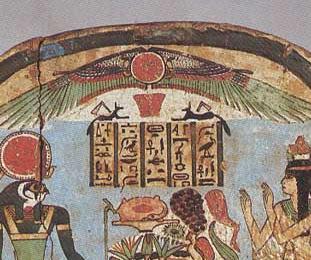Ankh Cross
also known as the Ansata Cross and the Egyptian Cross


Looking like a person standing with outstretched arms, the Ankh Cross is a looped Tau Cross and an old Egyptian hieroglyph meaning 'life'. It sometimes goes by the exotic name Key of the Nile. (For a different type of Looped Cross, see Carolingian Cross.)
There are several theories about the origin of this design. One suggestion is that the symbol looks like the posts that aligned the banks of the Nile River to indicate the high-water mark of floods. Since the floods bring new and fertile soil, this became the symbol of renewed life.
Another theory is from the symbolic representation of a sandal thong with a loop going around the ankle. (The English word 'ankle' is derived from Indo-European 'ank'.) In old Egyptian, 'sandal thong' and 'life' had the same pronunciation (homophony). Deciding on a hieroglyph for 'sandal thong' was relatively easy; they simply drew what they saw. But deciding on something for the less tangible 'life', was a challenge. So they used the hieroglyph that had the same sound. This occurs frequently in non-phonetic languages and known as the Rebus Principle. (That's another term you can use to impress your friends.)

Ancient Egyptian relief with Ankh in the centre
And yet another theory to connect this hieroglyph to 'life' goes that the Ankh symbol is a sketch of the womb, in addition to being a sketch of the sexual union of male and female genitalia. By extension, we imagine zest, energy, reproduction, regeneration, and immortality.
For many civilisations using this symbol, the loop represented the sun and it was held by many gods including Atum, the sun-god of Heliopolis. The loop is also a perfect symbol that has neither beginning nor end, so it represents the eternal soul.
The entire symbol is also a key, to unlock hidden mysteries in the Kingdom of the Dead and was often used in funeral rites. The symbol also represents the Tree of Life, with its trunk and foliage.
Early Christians adopted this symbol because of its resemblance to the cross. In particular, it was adopted by the Coptic Church of Egypt. (See Coptic Cross)
Dr Roman links the Ankh Cross to the Tau and says:
The Ankh is a great example of the veneration of the cross in pre-Christian times. The circle above the Tau was simply a handle by which people could hold the Cross as they walked. The Ethiopian Church has maintained this tradition since their priests and bishops are expected to be always holding a hand Cross, especially when they are speaking to others. (One Ethiopian priest once told me that if he didn't have his hand Cross, his bishop would immediately ask him, "Where is it?") When one approaches an Ethiopian (or Coptic) priest, he extends his hand Cross out so that one may reverence it with a kiss and then press it to one's forehead.
The Tau was honoured highly as the symbol of life also by Jews, as we know, and it was the "T" symbol that the Children of Israel painted on their doorposts at the first Passover with the blood of the lamb. The brazen serpent that was made and hoisted onto a pole also made the "T" shape - and in the third chapter of John's Gospel, Jesus affirms that he too would be lifted up like that serpent - which is why Russian Orthodox, to this day, prefer to have their neck Crosses made from brass or bronze and they sometimes wear a little bronze serpent around their necks together with their baptismal Crosses to recall Christ's words! (The Jews later called the brazen serpent "Kundun" - which is the Dalai Lama's title in Tibetan, but I don't know if this is a coincidence or not - but they later destroyed it as it came to be worshipped by the Jews).
In Egypt, the early Greek missionaries quickly took the opportunity to tell the people there that the Tau they loved so much was the symbol of the Son of God Whose Gospel they came to deliver to them. The Coptic Church later developed an actual aversion to the Tau (so a Coptic monk told me) because it reminded them of the Ankh symbol which was a hearkening to paganism for them. Nonetheless, the Tau became wildly popular in Europe as the Ansata Cross, becoming the emblem of St. Anthony of Egypt and of St. Francis of Assisi. Tertullian and others wrote that the letter "T" indicated the shape of the true Cross of our Lord.
The symbol remains popular with Christians today. It reminds them of the eternal life through Christ. (Jesus said, "I am the way and the truth and the life. No one comes to the Father except through me." - John 14:6)
The 'correct' pronunciation of ankh is uncertain. Some say onk or onch, but ank (as in 'ankle') seems the more commonly accepted pronunciation.

